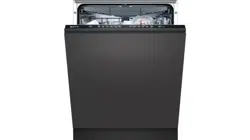Documents: Go to download!
User Manual
- User Manual - (English)
- Supplemental - (English)
- [global.common.document.title.SI] - (English)
- Installation Instruction - (English)
- Product spec sheet - (English)
- EU Datasheet - (English)
- EU Energy Label - (English)
- Familiarising yourself with your appliance
- Features
- Basic operation
- Cleaning and servicing
- Troubleshooting
Table of contents
USER MANUAL Dishwasher
Familiarising yourself with your appliance
Appliance
You can find an overview of the parts of your appliance here.
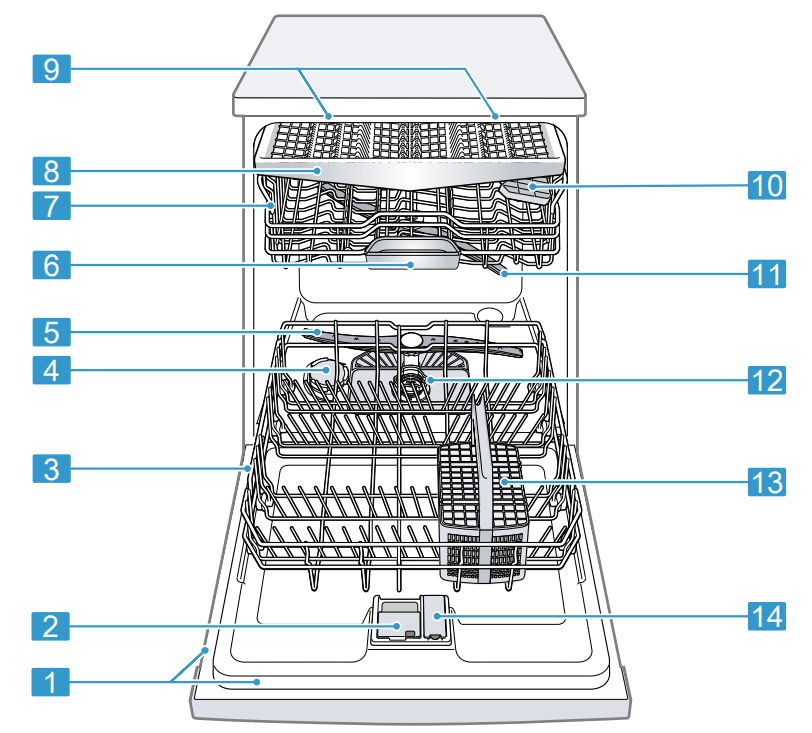
| 1.Rating plate | Rating plate with E number and FD number → Page 59. The data you need for Customer Service → Page 58. |
| 2. Detergent dispenser | Detergent → Page 32 is added to the detergent dispenser. |
| 3. Bottom basket | Bottom basket → Page 24 |
| 4. Dispenser for special salt | Add special salt for the Water softening system → Page 29 to the dispenser for special salt. |
| 5. Lower spray arm | The lower spray arm washes the tableware in the bottom basket. If the tableware has not been washed properly, clean the spray arms. → "Cleaning spray arms", Page 44 |
| 6. Tablet collecting tray | During the wash cycle tablets automatically fall out of the detergent dispenser into the tablet collecting tray where they can fully dissolve. |
| 7. Top basket | Top basket → Page 23 |
| 8. Cutlery drawer | Cutlery drawer → Page 24 |
| 9. EmotionLight | Interior lighting of the appliance. → "Overview of basic settings", Page 40 |
| 10. Etagere | Etagere → Page 25 |
| 11. Upper spray arm | The upper spray arm washes the tableware in the top basket. If the tableware has not been washed properly, clean the spray arms. → "Cleaning spray arms", Page 44 |
| 12. Filter system | Filter system → Page 43 |
| 13. Cutlery basket | Cutlery basket → Page 24 |
| 14. Dispenser for rinse aid | Add rinse aid for the Rinse aid system → Page 31 to the dispenser for rinse aid. |
Controls
The controls are used to configure all functions of your appliance and to obtain information about the operating status.
With some buttons you can perform different functions.
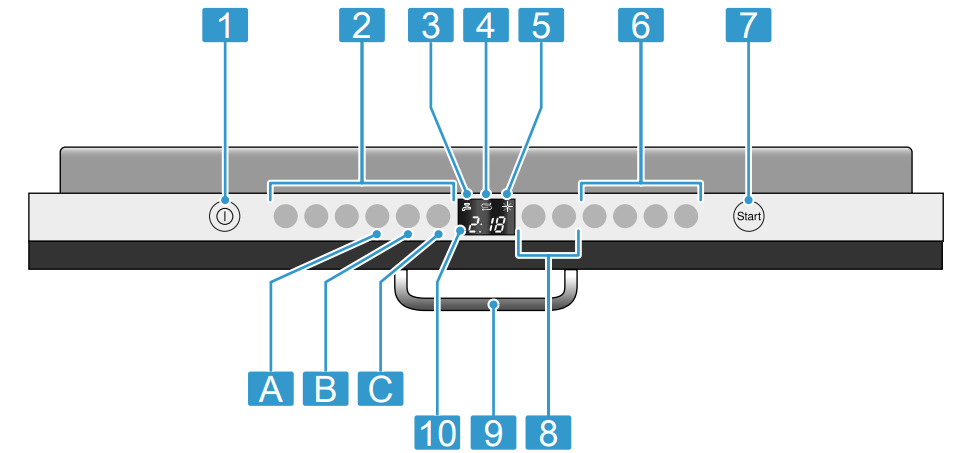
1 ON/OFF button  | Switching on the appliance → Page 37 Switching off the appliance → Page 38 |
| 2 Programme buttons | Programmes → Page 19 |
| 3 Water supply display | Display for water supply lights up → Page 46 |
| 4 Special salt refill indicator | Water softening system → Page 29 |
| 5 Rinse aid refill indicator | Rinse aid system → Page 31 |
| 6 Programme buttons and additional functions | Programmes → Page 19 Additional functions → Page 21 |
| 7 Start button Start and reset button Reset 3 sec | Starting the programme → Page 38 Terminating the programme → Page 38 |
| 8 Timer programming | Setting timer programming → Page 38 |
| 9 Door opener | Opening the appliance door → Page 37 |
| 10 Display | The display shows information about the remaining running time or the basic settings. You can change the basic settings via the display and the setting buttons. → "Changing basic settings", Page 41 |
Features
You can find an overview of the possible features of your appliance and how to use them here.
These features depend on the model of your appliance.
Top basket
Arrange cups and glasses in the top basket.
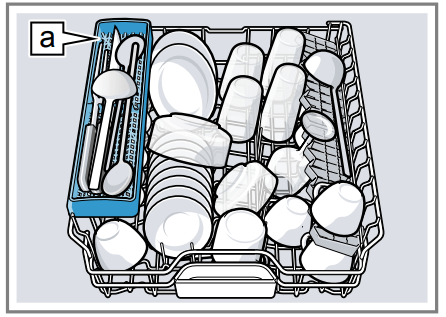
Knife shelf a
You can adjust the height of the top basket to make room for larger items of tableware.
Adjusting top basket with side levers
To wash large items of tableware in the baskets, adjust the shelf position of the top basket.
1. Pull out the top basket.
2. To prevent the basket from suddenly dropping down, hold the side of the basket by the top edge.
3. Press in the levers on the right and left on the outside of the basket.
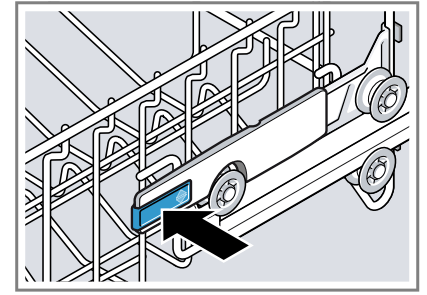
The basket can then slip down slightly.
4. Raise or lower the basket evenly to the right level. → "Basket heights", Page 27
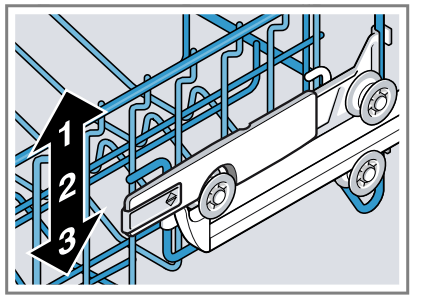
Check that the basket is level on both sides.
5. Slide the basket back in.
Adjusting top basket with pairs of rollers
To wash large items of tableware in the baskets, adjust the shelf position of the top basket.
1. Pull out the top basket.
2. Remove the basket.
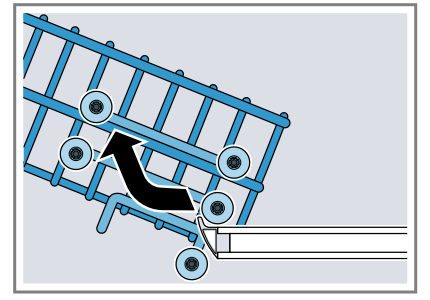
3. Insert the basket at the right basket height. → "Basket heights", Page 27
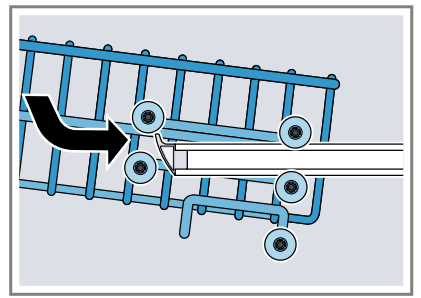
Check that the basket is level on both sides.
4. Slide the basket back in.
Bottom basket
Arrange pans and plates in the bottom basket.
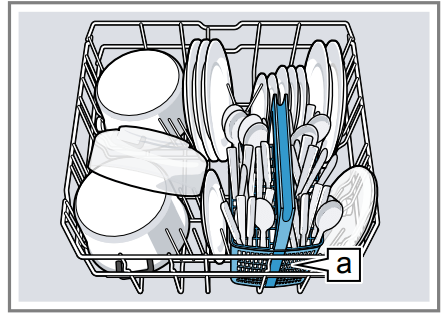
Cutlery basket a
Large plates up to a diameter of 31/34 cm1 can be arranged as shown.
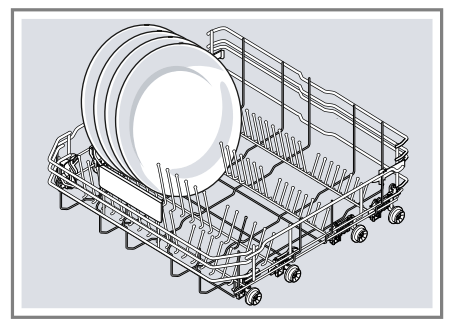
Cutlery basket
Arrange cutlery in the cutlery basket, always without sorting it and with the sharp points downwards.
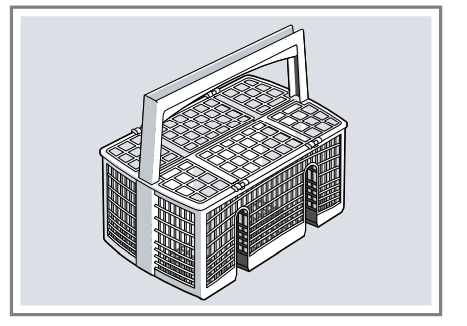
Cutlery drawer
Arrange cutlery in the cutlery drawer.

Arrange cutlery with the points and sharp edges downwards. You can reorganise the cutlery drawer to make more space for longer/wider items of cutlery.
Reorganising cutlery drawer
You can fold down the side shelves and front prongs to make more space for longer/wider items of cutlery.
1. To fold down a side shelf, push the lever forwards 1 and fold down the side shelf 2.
2. To fold down the front prongs, push the lever forwards and fold down the prongs 3
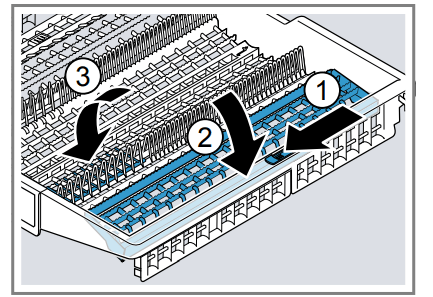
Tip
If you want to return the cutlery drawer to the original position, fold the side shelf back up until it clicks into position.
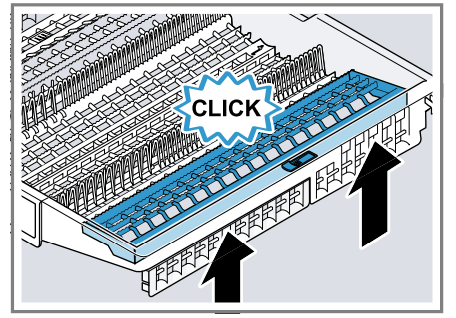
Etagere
Use the etagere and space underneath for small cups and glasses or for large items of cutlery, e.g. wooden spoons or serving cutlery.

You can adjust the height of the etagere.
If you do not need the etagere, you can fold it up.
Adjusting etagere
You can adjust the height of the etagere.
1. Position the etagere vertically and pull it upwards 1
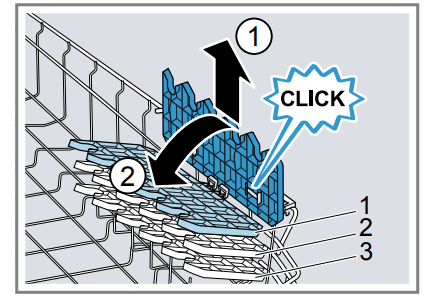
2. Position the etagere at a slight angle and move to the right height 2.
3. Push the etagere down.
Folding prongs
Use the folding prongs to position tableware securely, e.g. plates.
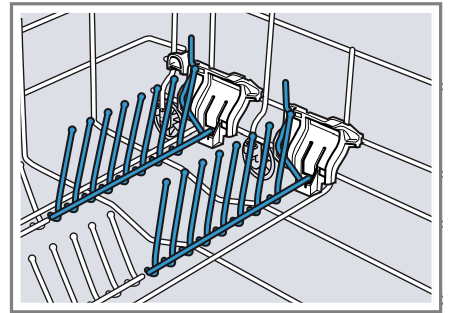
You can fold the prongs down to position pans, bowls and glasses better.
Folding down prongs
If you do not need the prongs, fold them down.
1. Push the lever forwards 1 and fold down the prongs 2

2. To use the folding prongs again, fold them back up.
Small items holder
Use the small items holder to position small items of tableware, e.g. light plastic parts.
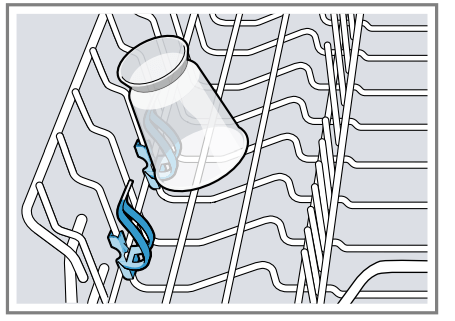
Knife shelf
Use the knife shelf for long, sharp objects and long items of cutlery
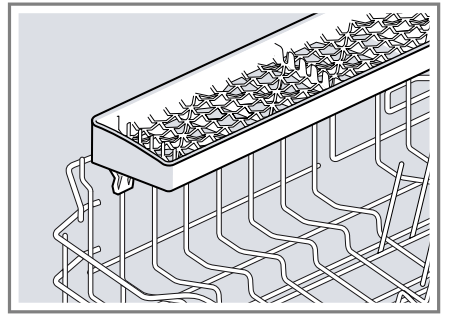
Baking sheet spray head
Use the baking sheet spray head to clean large items of tableware, e.g. trays, grilles and plates.

Arrange max. 2 baking sheets and 2 grilles as shown to ensure that the spray jet can reach all parts.
Inserting baking sheet spray head
Use the baking sheet spray head instead of the top basket to clean large trays, grilles and plates.
1. Remove top basket.
2. Insert the baking sheet spray head in the holder 1 and turn to the right 2

Removing baking sheet spray head
If you no longer require the baking sheet spray head, remove it from the appliance.
1. Turn the baking sheet spray head anticlockwise and remove from the holder.
2. Insert the top basket in the appliance.
Basket heights
Set the baskets at the right height.
Appliance height 81.5 cm with cutlery basket


Appliance height 81.5 cm with cutlery drawer

Appliance height 86.5 cm with cutlery basket

Appliance height 86.5 cm with cutlery drawer

Basic operation
You can find out everything you need to know about operating your appliance here
Opening appliance door
1. If the childproof lock1 is not activated, open the appliance door.
2. If the childproof lock1 is activated, press the catch of the lock to the right 1 and open the appliance door 2.
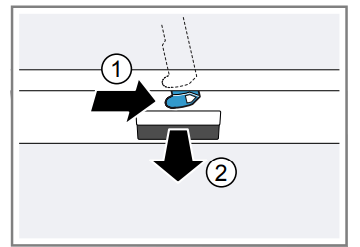
Switching on the appliance
Press 
The Eco 50° programme is set by default.
The Eco 50° programme is an especially environmentally friendly programme and ideal for normally soiled tableware. It is the most efficient programme for the combination of energy/water consumption for this type of tableware and evidences conformity with the EU Ecodesign Order.
If you do not perform any actions on the appliance for 15 minutes, the appliance will automatically switch off.
Setting a programme
To adjust the wash cycle to the soiling level of the tableware, select a suitable programme.
- Press the right programme button. → "Programmes", Page 19
The programme is set and the programme button flashes.
Setting additional functions
You can set additional functions to complete the washing programme selected.
Note: The additional functions which can be used depend on the programme selected. → "Programmes", Page 19
- Press the button for the relevant additional function. → "Additional functions", Page 21
The additional function is set and the additional function button flashes.
Setting timer programming
You can delay the start of the programme by up to 24 hours.
1. Press +.
"h:01" appears in the display.
2. Use + or - to set the required start time for the programme.
3. Press Start.
Starting the programme
- Press Start.
The programme has ended when the display shows "0:00".
Interrupting programme
Note: When you open the appliance door once the appliance has heated up, leave the door slightly ajar for a few minutes and then close it. This will help prevent excess pressure building up in the appliance and stop the appliance door bursting open.
1. Press  .
.
The programme is saved and the appliance switches off.
2. Press  to resume the programme.
to resume the programme.
Terminate programme
To end a programme early or to switch from a programme that has already started, you will need to terminate it first.
1. Open the appliance door.
2. Press Rset 3 sec for approx. 3 seconds.
3. Close the appliance door.
The programme is terminated and ends after approx. 1 minute.
Switching off appliance
1. Please note the information on Safe use → Page 11.
2. Press  .
.
3. To prevent damage from dripping water, turn the water tap off tight (not applicable to appliances with Aqua-Stop).
Tip: If you press  during the wash cycle, the programme currently running will be interrupted. When you switch the appliance back on, the programme continues automatically.
during the wash cycle, the programme currently running will be interrupted. When you switch the appliance back on, the programme continues automatically.
Cleaning and servicing
To keep your appliance working efficiently for a long time, it is important to clean and maintain it carefully
Cleaning the tub
1. Remove any coarse soiling in the interior with a damp cloth.
2. Add detergent to the detergent dispenser.
3. Select the programme with the highest temperature. → "Programmes", Page 19
4. Start the programme without tableware. → Page 38
Self-cleaning interior
To remove deposits, the appliance self-cleans the interior at regular intervals.
The programme sequence is automatically adjusted for self-cleaning, e.g. the cleaning temperature is briefly increased. Consumption values, e.g. water and electricity, may also increase.
If the interior is no longer self-cleaned adequately and deposits occur, see this information: → "Cleaning the tub", Page 42.
Cleaning products
Only use suitable cleaning products to clean your appliance. → "Safe use", Page 11
Tips on appliance care
Follow the tips on appliance care to make sure your appliance functions properly at all times.
| Action | Benefit |
| Wipe the door seals, the front of the dishwasher and the control panel regularly using a damp cloth and washing-up liquid. | This ensures the parts of the appliance will remain clean and hygienic. |
| If the appliance is not going to be used for a while, leave the door slightly ajar. | This will prevent unpleasant odours. |
Easy Clean
Deposits can cause your dishwasher to malfunction, e.g. due to grease or limescale. To avoid such faults and reduce odours, we recommend cleaning your appliance at regular intervals.
Easy Clean used in combination with commercially available machine care products is a suitable programme for cleaning your dishwasher.
Run Easy Clean without tableware if the indicator for Easy Clean lights up on the control panel or if advised to do so by the display. The indicator will go out after you have run Easy Clean. If your appliance does not have a reminder function, follow the directions for use on the machine care products.
Performing Easy Clean
Run the Easy Clean programme if the indicator for Easy Clean lights up on the control panel or if advised to do so by the display
1. Remove any coarse soiling in the interior with a damp cloth.
2. Clean filters.
3. Add the machine care product to the appliance.
4. Press  .
.
5. Press Start.
Easy Clean is run.
As soon as machine care has finished, the indicator for Easy Clean goes out.
Filter system
The filter system removes coarse soiling from the dishwashing cycle.

Cleaning filters
Soiling in the dishwashing water may block the filters.
1. After each wash check the filters for residue.
2. Turn the coarse filter anticlockwise 1 and remove the filter system 2 .
‒ Check that no foreign objects fall into the sump.
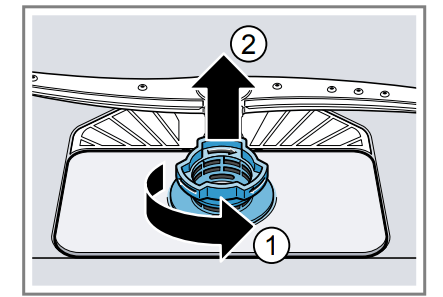
3. Pull down the micro filter to remove.

4. Press the locking catches 1 together and lift the coarse filter out 2 .
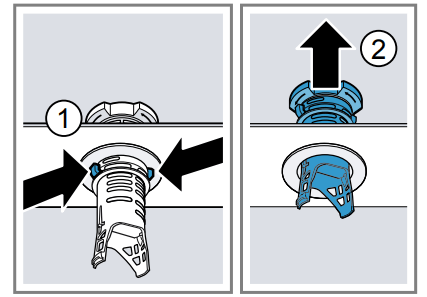
5. Clean the filter elements under running water. Carefully clean the rim of dirt between the coarse and the fine filter.
6. Re-assemble the filter system. Make sure that the locking catches on the coarse filter click into position.
7. Insert the filter system into the appliance and turn the coarse filter clockwise. Make sure that the arrow markings match up.
Cleaning spray arms
Limescale and soiling in the dishwashing water may block the nozzles and bearings on the spray arms. Clean the spray arms regularly.
1. Unscrew the upper spray arm 1 and pull down to remove 2
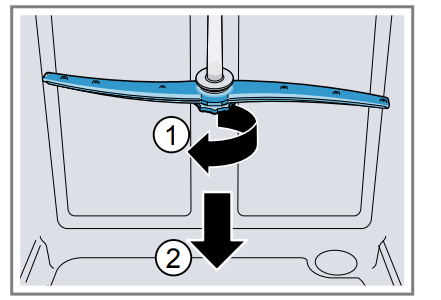
2. Pull up the lower spray arm to remove.
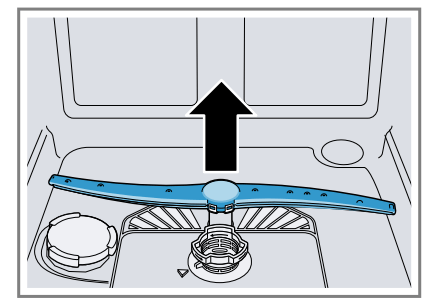
3. Check the outlet nozzles on the spray arms for blockages under running water and remove any foreign bodies.
4. Insert the lower spray arm.
The spray arm clicks into position.
5. Insert the upper spray arm and screw it firmly in place.
Troubleshooting
You can rectify minor faults on your appliance yourself. Read the troubleshooting information before contacting Customer Service. This will avoid unnecessary costs.
Appliance safety
| Fault | Cause | troubleshooting |
| Appliance door will not open or cannot be opened easily. | Childproof lock is activated. | ▶ Open the appliance door. → Page 37 |
Error code / Fault display / Signal
| Fault | Cause | troubleshooting |
| E:12 lights up. | Heating element is furred up. | 1. Descale the appliance. 2. Operate the appliance with the Water softening system. |
| E:14 lights up. | Water protection system is activated. | 1. Turn off the water tap. 2. Call Customer Service → Page 58. |
| E:15 lights up. | Water protection system is activated. | 1. Turn off the water tap. 2. Call Customer Service → Page 58. |
| E:16 lights up. | Water is continuously running into the appliance. | 1. Turn off the water tap. 2. Call Customer Service → Page 58. |
| E:18 or indicator for water supply lights up. | Supply hose is kinked. | ▶ Install the supply hose without kinks. |
| Water tap is turned off. | ▶ Turn on the water tap. | |
| Water tap is jammed or furred up. | ▶ Turn on the water tap. The flow rate must be at least 10 l/ min when the water supply is open. | |
| Filter in the water supply is blocked. | 1. Switch off the appliance. 2. Pull out the mains plug. 3. Turn off the water tap. 4. Unscrew the water connection. 5. Remove the filter from the supply hose  6. Clean the filter. 7. Re-insert the filter in the supply hose. 8. Screw the water connection back on. 9. Check the water connection for leaks. 10. Restore the power supply. 11. Switch the appliance on. | |
| E:22 lights up. | Filters are soiled or blocked. | ▶ Clean the filters. → "Cleaning filters", Page 43 |
| E:24 lights up. | Wastewater hose is blocked or kinked. | 1. Reposition the wastewater hose without kinks. 2. Remove residues. |
| Siphon connection is still sealed. | ▶ Check the connection to the siphon and open if necessary. | |
| Cover of the wastewater pump is loose. | ▶ Secure the cover of the Wastewater pump → Page 57 so it clicks into position. | |
| E:25 lights up. | Wastewater pump is blocked. | ▶ Clean the wastewater pump. → "Clean wastewater pump", Page 57 |
| Cover of the wastewater pump is loose | ▶ Secure the cover of the Wastewater pump → Page 57 so it clicks into position. | |
| E:27 lights up. | Mains voltage is too low. | This is not a fault on the appliance. 1. Contact an electrician. 2. Have the mains voltage and electrical installation checked by an electrician. |
Another error code appears on the display. E:01 to E:30 | A technical fault is present. | 1. Press 2. Unplug the appliance or switch off the fuse. 3. Wait at least 2 minutes. 4. Insert the mains plug of the appliance in a socket or switch on the fuse. 5. Switch the appliance on. 6. If the problem occurs again: ‒ Press ‒ Turn off the water tap. ‒ Pull out the mains plug. ‒ Contact Customer Service → Page 58 and give the error code. |
Washing results
| Fault | Cause | troubleshooting |
| Tableware is not dry. | No rinse aid used or dosage set too low. | 1. Add Rinse aid → Page 31. 2. Set the amount of rinse aid to be dispensed. |
| Selected programme has no drying phase | ▶ Select a programme with drying. | |
| Water collects in recesses of the tableware or cutlery. | ▶ Position tableware at an angle where possible.  | |
| The combined detergent used has a poor drying performance. | 1. Use rinse aid to improve drying performance. 2. Use a different combined detergent with a better drying performance. | |
| Extra Dry not activated to improve drying performance. | ▶ Activate Extra Dry. | |
| Tableware removed too early or drying process not yet ended. | 1. Wait until the programme ends. 2. Only remove tableware 30 minutes after the programme has ended. | |
| Rinse aid used has a limited drying performance. | ▶ Use a name-brand rinse aid. Eco products may have limited effectiveness. | |
| Plastic tableware is not dry | Not a fault. As plastic does not store heat so well, it also does not dry as well. | ▶ No remedial action possible. |
| Cutlery is not dry. | Cutlery not arranged properly in the cutlery basket or cutlery drawer. | 1. Arrange the cutlery properly. → "Arrange tableware", Page 36 2. Arrange cutlery individually where possible. 3. Avoid points of contact |
| Appliance interior still wet after wash cycle. | Not a fault. The condensation drying principle causes water droplets in the tub – they are indeed desirable here. The moisture in the air condenses on the inside walls, runs off and is pumped out. | No action required. |
| Remnants of food on tableware. | Tableware was placed too close together. | 1. Arrange tableware with sufficient space in between. The spray jets must reach the surfaces of the tableware. 2. Avoid points of contact. |
| Basket is overfilled. | 1. Arrange tableware with sufficient space in between. The spray jets must reach the surfaces of the tableware. 2. Avoid points of contact. | |
| Spray arm rotation is blocked. | ▶ Arrange tableware so that it does not obstruct spray arm rotation. | |
| Spray arm nozzles are blocked. | ▶ Clean the Spray arms → Page 44. | |
| Filters are soiled. | ▶ Clean the filters. → "Cleaning filters", Page 43 | |
| Filters are inserted incorrectly and/or not engaged. | 1. Insert the filters properly. → "Filter system", Page 43 2. Engage the filters | |
| Washing programme selected too weak. | ▶ Select a more intensive washing programme. ▶ Adjust the sensitivity of the sensors. | |
| Tableware has been precleaned too intensely. The sensors chose a weaker programme. Stubborn soiling cannot be entirely removed. | ▶ Only remove large remnants of food and do not prerinse tableware. | |
| Tall narrow receptacles in corner areas are not rinsed adequately. | ▶ Do not position tall narrow receptacles at too great an angle or in corner areas. | |
| Top baskets on right and left are not set to same height. | ▶ Set the top baskets on the left and right to the same level. → "Top basket", Page 23 | |
| Detergent residue in the appliance | Lid of the detergent dispenser is blocked by items of tableware parts and will not open. | 1. Arrange tableware in the top basket tableware so the tab collecting tray is not obstructed by tableware. → "Arrange tableware", Page 36 Items of tableware are blocking the dispenser lid. 2. Do not place tableware or fragrance dispensers in the tablet collecting tray. |
| The lid of the detergent dispenser is blocked by the tab and will not open. | ▶ Position the tab in the detergent dispenser crosswise, not vertically. | |
| Tabs are used in the quick or short programme. Dissolving time of the tab is not attained. | ▶ Select a more intensive Programme or use Powder detergent → Page 32. | |
| Washing effect and dissolving performance are reduced after a prolonged storage time or detergent is very lumpy. | ▶ Change your detergent → Page 32. | |
| Water marks on plastic parts. | Due to laws of physics droplet formation on plastic surfaces is unavoidable. After drying water marks are visible. | ▶ Select a more intensive programme. ▶ Position tableware at an angle. → "Arrange tableware", Page 36 ▶ Use rinse aid. → "Rinse aid", Page 31 ▶ Set the water softening system higher. |
| Wipeable or water-soluble coatings are present inside the appliance or on the door. | Detergent substances are deposited there. These coatings cannot generally be removed with chemicals. | ▶ Change your detergent → Page 32. ▶ Clean the appliance mechanically. |
| White coating is deposited in the appliance interior. | 1. Set the water softening system correctly. In most cases you will need to increase the setting. 2. Change your detergent if required. | |
| Special salt dispenser is not screwed tight. | ▶ Screw the special salt dispenser tight. | |
| Stubborn white coatings are present on tableware, inside the appliance or the door. | Detergent substances are deposited there. These coatings cannot generally be removed with chemicals. | ▶ Change your detergent → Page 32. ▶ Clean the appliance mechanically. |
| The hardness range is set incorrectly or the water hardness is greater than 62 °E (8,9 mmol/l). | ▶ Set the Water softening system → Page 29 to the water hardness or add special salt. | |
| 3in1/organic/eco detergent is not effective enough. | ▶ Set the Water softening system → Page 29 to the water hardness and use separate detergents (proprietary detergent, special salt, rinse aid). | |
| Too little detergent is being used. | ▶ Increase the amount of detergent used or change Detergent → Page 32. | |
| Washing programme selected too weak. | ▶ Select a more intensive washing programme. ▶ Adjust the sensitivity of the sensors | |
| Tea residue or lipstick marks on tableware. | Washing temperature is too low. | ▶ Select a programme with a higher washing temperature. |
| Too little detergent is being used or is unsuitable. | ▶ Use a suitable Detergent → Page 32 and follow the manufacturer's instructions for the amount to be used. | |
| Tableware has been precleaned too intensely. The sensors chose a weaker programme. Stubborn soiling cannot be entirely removed. | ▶ Only remove large remnants of food and do not prerinse tableware | |
| Coloured coatings (blue, yellow, brown) that are difficult or impossible to remove are present inside the appliance or on stainless steel tableware. | The formation of films is due to substances contained in vegetables (cabbage, celery, potatoes, noodles, etc.) or tap water (manganese). | ▶ Clean the appliance. You can remove deposits with Mechanical cleaning → Page 42 or a machine cleaning product. It may not always be possible to completely remove deposits but they are harmless to health. |
| he formation of films is due to metal components on silver or aluminium tableware. | ▶ Clean the appliance. You can remove deposits with Mechanical cleaning → Page 42 or a machine cleaning product. It may not always be possible to completely remove deposits but they are harmless to health. | |
| Coloured deposits (yellow, orange, brown) that are easy to remove are present inside the appliance (mainly at the bottom). | The formation of films is due to ingredients of food remnants and tap water (limescale) "soaplike". | 1. Check the setting of the water softening system. → "Setting water softening system", Page 29 2. Add special salt. → "Adding special salt", Page 29 3. If you are using combined detergents (tabs), activate the water softening system. Follow the information about detergents. → "Information on detergents", Page 34 |
| Plastic parts inside the appliance are discoloured. | Plastic parts inside the appliance may become discoloured during the life of the dishwasher. | ▶ Discolouration can come about and will not impair functioning of the appliance. |
| Plastic parts are discoloured. | Washing temperature is too low. | ▶ Select a programme with a higher washing temperature. |
| Tableware has been precleaned too intensely. The sensors chose a weaker programme. Stubborn soiling cannot be entirely removed. | ▶ Only remove large remnants of food and do not prerinse tableware. | |
| Removable streaks are present on glasses, glassware with a metallic appearance and cutlery. | Amount of rinse aid to be dispensed is set too high. | ▶ Set the rinse aid system to a lower setting. |
| No rinse aid has been added. | ▶ → "Adding rinse aid", Page 31 | |
| Detergent residue is present in the final rinse. Lid of the detergent dispenser is blocked by tableware items and will not open fully. | 1. Arrange tableware in the top basket tableware so the tab collecting tray is not obstructed by tableware. → "Arrange tableware", Page 36 Items of tableware are blocking the dispenser lid. 2. Do not place tableware or fragrance dispensers in the tablet collecting tray. | |
| Tableware has been precleaned too intensely. The sensors chose a weaker programme. Stubborn soiling cannot be entirely removed. | ▶ Only remove large remnants of food and do not prerinse tableware. ▶ Adjust the sensitivity of the sensors. | |
| Irreversible clouding of glassware. | Glasses are not dishwasherproof, only suitable for dishwashers. | ▶ Use dishwasher-proof glasses. ▶ Avoid a lengthy steam phase (standing time after wash cycle ends). ▶ Use a programme with a lower temperature. ▶ Set the softening system to the water hardness. ▶ Use detergent with a glass protection component. |
| Rust spots on cutlery | Cutlery is not sufficiently rust-resistant. Knife blades are often more severely affected. | ▶ Use rust-resistant tableware. |
| Cutlery may also rust if washed together with rusting items. | ▶ Do not wash rusting items. | |
| Salt content in washing water is too high. | 1. Remove any spilled special salt from the tub. 2. Screw the cap of the special salt dispenser on tight. | |
| Detergent residue is present in the detergent dispenser or the tablet collecting tray | Spray arms were blocked by tableware so detergent was not rinsed out. | ▶ Check that the spray arms are not blocked and can rotate freely |
| Detergent dispenser was damp when detergent was added. | ▶ Only add detergent to a detergent dispenser when dry | |
| Excessive formation of foam occurs. | Hand washing-up liquid is present in dispenser for rinse aid. | ▶ Immediately add rinse aid to the dispenser. → "Adding rinse aid", Page 31 |
| Rinse aid has been spilled. | ▶ Remove the rinse aid with a cloth. | |
| Detergent or appliance care product used causes excessive foaming. | ▶ Change the brand of detergent. |
Information on display panel
| Fault | Cause | troubleshooting |
| Special salt refill indicator lights up. | Insufficient special salt. | ▶ Add Special salt → Page 29. |
| Sensor does not detect special salt tablets. | ▶ Do not use special salt tablets. | |
| Refill indicator for special salt does not light up. | Water softening system is switched off. | ▶ Setting water softening system → Page 29 |
| Refill indicator for rinse aid lights up. | Insufficient rinse aid. | 1. Add Rinse aid → Page 31. 2. Set the amount of rinse aid to be dispensed. |
| Refill indicator for rinse aid does not light up. | Rinse aid system is switched off. | ▶ → "Setting the amount of rinse aid", Page 32 |
| Display flashes. | Appliance door is not closed properly | ▶ Close the appliance door. ‒ Arrange the tableware so that no parts project beyond the basket and prevent the appliance door from closing properly |
Malfunctions
| Fault | Cause | troubleshooting |
| Water is left in the appliance at the end of the programme. | Filter system or area under the filters is blocked. | 1. Clean the Filters → Page 43. 2. Clean the Wastewater pump → Page 57. |
| Programme has not yet ended. | ▶ Wait until the programme ends or cancel the programme with reset. ▶ → "Terminate programme", Page 38 | |
| Appliance cannot be switched on or operated. | Appliance functions have failed. | 1. Pull out the mains plug or switch off the fuse. 2. Wait at least 2 minutes. 3. Connect the appliance to the power supply. 4. Switch the appliance on. |
| Appliance does not start. | The mains fuse has tripped. | ▶ Check the relevant fuse |
| Mains cable is not inserted. | 1. Check whether the socket works. 2. Check whether the mains cable is properly inserted in the socket and on the rear of the appliance. | |
| Appliance door is not closed properly. | ▶ Close the appliance door. | |
| Programme starts automatically. | You did not wait until programme ended. | ▶ → "Terminate programme", Page 38 |
| Appliance stops during the programme or cuts out. | Appliance door is not closed properly. | ▶ Close the appliance door. |
| Power and/or water supply has been interrupted. | 1. Check the power supply. 2. Check the water supply. | |
| Top basket is pressing against inner door and preventing appliance door from being closed securely. | ▶ Check whether the rear panel of the appliance is being pressed in by a socket or hose holder that has not been removed. ▶ Arrange the tableware so that no parts project beyond the basket and prevent the appliance door from closing properly. |
Mechanical damage
| Fault | Cause | troubleshooting |
| Appliance door cannot be closed. | Door lock has been activated. | ▶ Close the appliance door with greater force. |
| Door cannot be closed due to installation method. | ▶ Check whether the appliance has been installed properly. When closed, the appliance door, its decor or attached parts should not knock against adjacent cabinets or the worktop. | |
| Lid on the detergent dispenser cannot be closed. | Detergent dispenser or lid are blocked by sticky detergent residue. | ▶ Remove detergent residue. |
Noise
| Fault | Cause | troubleshooting |
| Filling valves making knocking noises. | Caused by the domestic installation. No appliance fault present. Does not affect functioning of the appliance. | ▶ Can only be remedied in the domestic installation. |
| Knocking or rattling noise. | Spray arm is striking tableware. | ▶ Arrange tableware so that the spray arms do not strike tableware. |
| With a small load the water jets directly strike against the tub. | ▶ Distribute the tableware evenly. ▶ Load the appliance with more tableware. | |
| Light items of tableware move about during the wash cycle. | ▶ Position light items of tableware securely |
Clean wastewater pump
Large remnants of food or foreign bodies can block the wastewater pump. As soon as the washing water no longer drains properly, the wastewater pump must be cleaned.
1. Disconnect the appliance from the power supply.
2. Remove the top and bottom basket.
3. Remove the filter system.
4. Scoop out any water. Use a sponge if necessary.
5. Prise off the pump cover using a spoon and grip it by the crosspiece.
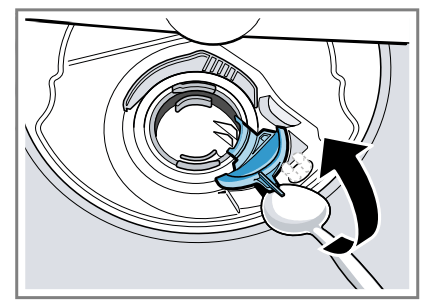
6. Lift the pump cover inwards at an angle and remove.
7. Remove any remnants of food and foreign bodies in the area of the impeller.
8. Insert the pump cover 1 and press down 2.
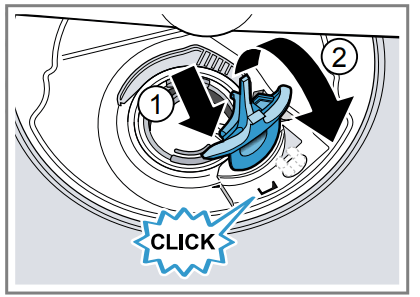
The pump cover clicks into position.
9. Install the filter system.
10.Insert the top and bottom basket.
See other models: KI7853D30G/01 C15CR22N2/57 E1420N0/03 C26MT23N0/48 B4ACM5HH0B
 .
.